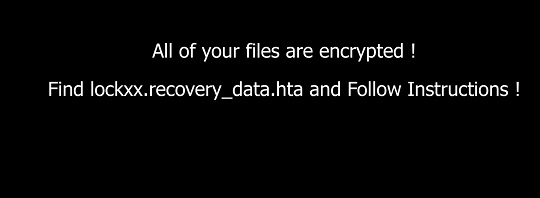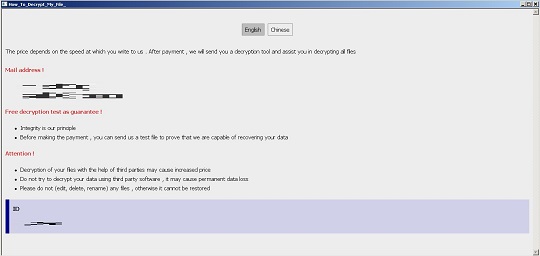Ransom.Win64.LOCKXX.THABEBD
Windows


Threat Type: Ransomware
Destructiveness: No
Encrypted:
In the wild: Yes
OVERVIEW
This Ransomware arrives on a system as a file dropped by other malware or as a file downloaded unknowingly by users when visiting malicious sites.
It encrypts files with specific file extensions. It drops files as ransom note. It avoids encrypting files with the following file extensions.
TECHNICAL DETAILS
Arrival Details
This Ransomware arrives on a system as a file dropped by other malware or as a file downloaded unknowingly by users when visiting malicious sites.
Installation
This Ransomware drops the following files:
- %ProgramData%\lockxxx.recovery_data.hta
- {Malware File Path}\info.log
- {Malware File Path}\err.log
- {Malware File Path}\enc.log
- {Malware File Path}\debug.log
- %ProgramData%\lockxx.bin
(Note: %ProgramData% is a version of the Program Files folder where any user on a multi-user computer can make changes to programs. This contains application data for all users. This is usually C:\ProgramData on Windows Vista, 7, 8, 8.1, 2008(64-bit), 2012(64-bit) and 10(64-bit), or C:\Documents and Settings\All Users on Windows Server 2003(32-bit), 2000(32-bit) and XP.)
It adds the following processes:
- cmd.exe /c schtasks /delete /tn \"Windows update00\" /f"
- cmd.exe /c schtasks /create /sc minute /mo 5 /tn "Windows update01" /tr "Powershell wevtutil el | Foreach-Object {Write-Host \"Clearing $_\"; wevtutil cl \"$_\"}" /ru "" /RL HIGHEST
- cmd.exe /c schtasks /create /tn shutdown00 /tr \"shutdown -r -t 0\" /sc once /st {Time} /ru \"\""
- cmd.exe /c "bcdedit /set {default} recoveryenabled No"
- cmd.exe /c "wmic shadowcopy delete /nointeractive"
- cmd.exe /c "bcdedit /set {default} bootstatuspolicy ignoreallfailures"
- cmd.exe /c "vssadmin delete shadows /All /Quiet"
- Explore.exe
It adds the following mutexes to ensure that only one of its copies runs at any one time:
- Global\(0_O)#######
- Local\RstrMgr-3887CAB8-533F-4C85-B0DC-3E5639F8D511-Session0000
- Local\RstrMgr3887CAB8-533F-4C85-B0DC-3E5639F8D511
Other System Modifications
This Ransomware adds the following registry entries as part of its installation routine:
HKEY_LOCAL_MACHINE\SOFTWARE\Microsoft\
Windows\CurrentVersion\Run
.lockxx = {Malware File Path} → Deletes afterward
HKEY_LOCAL_MACHINE\SOFTWARE\Microsoft\
Windows\CurrentVersion\Run
lockxx.recovery_data.hta = %ProgramData%\lockxx.recovery_data.hta
It changes the desktop wallpaper by modifying the following registry entries:
HKEY_CURRENT_USER\Control Panel\Desktop
Wallpaper = %ProgramData%\lockxx.bin
It sets the system's desktop wallpaper to the following image:
- %ProgramData%\lockxx.bin

Process Termination
This Ransomware terminates the following processes if found running in the affected system's memory:
- sqlservr.exe
- sqlwriter.exe
- sqlagent.exe
- fdhost.exe
- reportingservicesservice.exe
- omtsreco.exe
- tnslsnr.exe
- oracle.exe
- emagent.exe
- perl.exe
- msaccess.exe
- mysqld.exe
- mysqld-nt.exe
- msftesql.exe
- mysqld_opt.exe
- mydesktopservice.exe
- winword.exe
- excel.exe
- wordpad.exe
- outlook.exe
- sqlbrowser.exe
- winRAR.exe
- 7-Zip.exe
- Chrome.exe
It terminates processes or services that contain any of the following strings if found running in the affected system's memory:
- vss
- sql
- svc$
- memtas
- mepocs
- msexchange
- sophos
- veeam
- backup
- GxVss
- GxBlr
- GxFWD
- GxCVD
- GxCIMgr
- AeLookupSvc
- AppIDSvc
- Appinfo
- AppMgmt
- aspnet_state
- AudioSrv
- Windows Audio
- AxInstSV
- BDESVC
- Browser
- bthserv
- CertPropSvc
- COMSysApp
- CryptSvc
- CscService
- Offline Files
- DcomLaunch
- defragsvc
- DHCP Client
- Dnscache
- DNS Client
- dot3svc
- EapHost
- ehRecvr
- ehSched
- eventlog
- EventSystem
- fdPHost
- FDResPub
- FontCache
- gpsvc
- idsvc
- gupdate
- gupdatem
- hidserv
- hkmsvc
- IKEEXT
- IPBusEnum
- iphlpsvc
- IP Helper
- KeyIso
- KtmRm
- MMCSS
- LanmanServer
- Server
- Workstation
- lltdsvc
- lmhosts
- Mcx2Svc
- MpsSvc
- MSDTC
- MSiSCSI
- msiserver
- napagent
- Netlogon
- Netlogon
- Netman
- netprofm
- NlaSvc
- odserv
- p2pimsvc
- p2psvc
- PcaSvc
- PeerDistSvc
- BranchCache
- PerfHost
- PlugPlay
- Plug and Play
- PNRPAutoReg
- PNRPsvc
- PolicyAgent
- Power
- Power
- ProfSvc
- QWAVE
- RpcSs
- RasAuto
- RasMan
- RemoteAccess
- rpcapd
- RpcEptMapper
- RpcLocator
- SamSs
- SCardSvr
- Smart Card
- Schedule
- SCPolicySvc
- SDRSVC
- seclogon
- SensrSvc
- SessionEnv
- SharedAccess
- SNMPTRAP
- SNMP Trap
- Spooler
- Print Spooler
- sppsvc
- sppuinotify
- SSDPSRV
- SstpSvc
- stisvc
- StorSvc
- swprv
- SysMain
- Superfetch
- Sysmon64
- Sysmon64
- TapiSrv
- Telephony
- TermService
- Themes
- Themes
- THREADORDER
- TPAutoConnSvc
- TPVCGateway
- TrkWks
- UI0Detect
- UmRdpService
- upnphost
- UxSms
- VaultSvc
- Virtual Disk
- VGAuthService
- VMTools
- VMware Tools
- vmvss
- W32Time
- Windows Time
- wbengine
- WbioSrvc
- wcncsvc
- WdiSystemHost
- WebClient
- WebClient
- Wecsvc
- wercplsupport
- WerSvc
- WinDefend
- Winmgmt
- WinRM
- Wlansvc
- wmiApSrv
- WMPNetworkSvc
- WPCSvc
- WPDBusEnum
- wscsvc
- WSearch
- wuauserv
- wudfsvc
- WwanSvc
- aelookupsvc
Other Details
This Ransomware accepts the following parameters:
- -h → Display help menu
- -path {File Path} → Encrypts the specified path
- -mode {Integer} → Specify mode
- -nosize {Integer} →
- -size {Integer} →
- -skip {Directory} → Skip encrypting the specified directory
- -sleep {Integer} → Sleep duration in minutes
- -walk → Do not encryptfiles
- -clear → Clear system logs and self-delete
Ransomware Routine
This Ransomware encrypts files with the following extensions:
- .vdi
- .vhd
- .vhdx
- .vmdk
- .vmem
- .vswp
- .vmsn
- .vmx
- .dat
- .vib
- .vbk
- .psc
- .myd
- .frm
- .myi
- .mdb
- .mdf
- .ndf
- .ldf
- .accdb
- .db
- .odb
- .wdb
- .sql
- .ns
- .dbf
- .dmp
- .ora
- .zip
- .7z
- .rar
- .tar
- .gz,.tib
- .ba_
- .bak
- .bk
- .dsk
- .adf
- .in
- .txt
- .prt
- .cad
- .grf
- .edat
- .sldprt
- .0
- .1
- .2
- .3
- .4
- .5
- .6
- .7
- .8
- .9
- .mod
- .dwg
- .ini
- .dcm
- .arj
- .back
- .000
- .bco
- .kpr
- .rbk
- .rep
- .shl
- .sjc
- .php
- .python
- .asp
- .aspx
- .c
- .cpp
- .pyc
- .pyw
- .sln
- .scm
- .ps1
- .json
- .pptx
- .xls
- .xlsx
- .doc
- .docx
- .csv
- .jsp
- .sicck
- .bah
- .bal
It avoids encrypting files with the following strings in their file name:
- recovery_data.txt
- NTUSER.DAT
- ntuser.dat.log1
- ntuser.dat.log2
- bootmgr
- ntldr
- ntuser.dat
- ntuser.dat.log
- autorun.inf
- thumbs.db
- bootsect.bak
- bootfont.bin
- ntuser.ini
- desktop.ini
- boot.ini
- iconcache.db
It appends the following extension to the file name of the encrypted files:
- .lockxx
It drops the following file(s) as ransom note:
- {Encrypted Directory}\lockxxx.recovery_data.hta

It avoids encrypting files with the following file extensions:
- .jpg
- .vmsg
- .tdf
- .sample
- .xsl
- .xml
- .content
- .mof
- .sam
- .xsd
- .png
- .swf
- .js
- .css
- .gif
- .hxs
- .hds
- .wpl
- .url
- .ttf
- .snippet
- .trc
- .blf
- .rll
- .regtrans-ms
- .search-ms
- .icns
- .msstyles
- .cpl
- .jspx
- .hlp
- .lnk
- .deskthemepack
- .cmd
- .ics
- .adv
- .dll
- .ico
- .exe
- .com
- .nls
- .bat
- .rtp
- .spl
- .msu
- .rom
- .key
- .ocx
- .ps1
- .msp
- .386
- .drv
- .lock
- .mod
- .wpx
- .cab
- .idx
- .sys
- .icl
- .nomedia
- .cur
- .scr
- .hta
- .themepack
- .bin
- .diagcfg
- .shs
- .theme
- .prf
- .msc
- .mpa
- .msi
- .diagcab
- .ani
- .diagpkg
- .session
- .pol
- .lib
- .bmp
- .tmp
- .log
- .chm
- .wim
- .sdi
- .gho
- .pbk
SOLUTION
Step 1
Before doing any scans, Windows 7, Windows 8, Windows 8.1, and Windows 10 users must disable System Restore to allow full scanning of their computers.
Step 2
Note that not all files, folders, and registry keys and entries are installed on your computer during this malware's/spyware's/grayware's execution. This may be due to incomplete installation or other operating system conditions. If you do not find the same files/folders/registry information, please proceed to the next step.
Step 3
Delete this registry value
Important: Editing the Windows Registry incorrectly can lead to irreversible system malfunction. Please do this step only if you know how or you can ask assistance from your system administrator. Else, check this Microsoft article first before modifying your computer's registry.
- In HKEY_LOCAL_MACHINE\SOFTWARE\Microsoft\Windows\CurrentVersion\Run
- lockxx.recovery_data.hta=%ProgramData%\lockxx.recovery_data.hta
- lockxx.recovery_data.hta=%ProgramData%\lockxx.recovery_data.hta
Step 4
Reset your Desktop properties
Step 5
Search and delete this file
- %ProgramData%\lockxxx.recovery_data.hta
- {Malware File Path}\info.log
- {Malware File Path}\err.log
- {Malware File Path}\enc.log
- {Malware File Path}\debug.log
- %ProgramData%\lockxx.bin
Step 6
Deleting Scheduled Tasks
The following {Task Name} - {Task to be run} listed should be used in the steps identified below:
- Name: Windows update01
- Trigger:One Time →{After triggered, repeat every 5 minutes indefinitely}
- Action: Start a program → {Powershell wevtutil el | Foreach-Object {Write-Host \"Clearing $_\"; wevtutil cl \"$_\"}}
- Name: shutdown00
- Trigger: One Time → {Creation Date}
- Action: Start a program → {Shutdown -r -t 0}
For Windows 2000, Windows XP, and Windows Server 2003:
- Open the Windows Scheduled Tasks. Click Start>Programs>Accessories>
System Tools>Scheduled Tasks. - Locate each {Task Name} values listed above in the Name column.
- Right-click on the said file(s) with the aforementioned value.
- Click on Properties. In the Run field, check for the listed {Task to be run}.
- If the strings match the list above, delete the task.
For Windows Vista, Windows 7, Windows Server 2008, Windows 8, Windows 8.1, and Windows Server 2012:
- Open the Windows Task Scheduler. To do this:
• On Windows Vista, Windows 7, and Windows Server 2008, click Start, type taskschd.msc in the Search input field, then press Enter.
• On Windows 8, Windows 8.1, and Windows Server 2012, right-click on the lower left corner of the screen, click Run, type taskschd.msc, then press Enter. - In the left panel, click Task Scheduler Library.
- In the upper-middle panel, locate each {Task Name} values listed above in the Name column.
- In the lower-middle panel, click the Actions tab. In the Details column, check for the {Task to be run} string.
- If the said string is found, delete the task.
Step 7
Scan your computer with your Trend Micro product to delete files detected as Ransom.Win64.LOCKXX.THABEBD. If the detected files have already been cleaned, deleted, or quarantined by your Trend Micro product, no further step is required. You may opt to simply delete the quarantined files. Please check the following Trend Micro Support pages for more information:
Did this description help? Tell us how we did.


